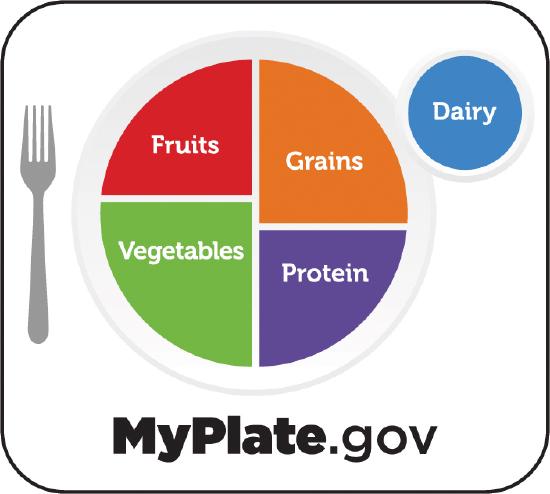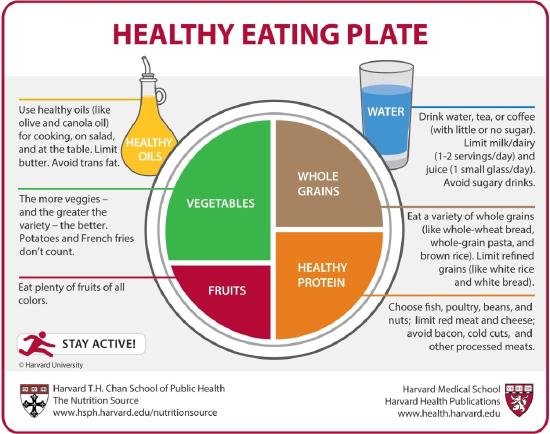2.3: Understanding Food Patterns
- Page ID
- 20934
Learning Objective
- Describe various food patterns that can be used to design a healthy diet.
The current Dietary Guidelines for Americans focus on the use of food patterns as a growing body of research shows support for the use of overall dietary eating patterns in developing guidance for populations.1 Let's take a look at a few food patterns, or tools, that can be used to design a healthy diet.
MyPlate
For many years, the US government has been encouraging Americans to develop healthful dietary habits through the development of various food guides. The latest food guide is called MyPlate and is a pictorial representation of the Dietary Guidelines. The MyPlate program uses a tailored approach to give people the needed information to help design a healthy diet. The plate is divided to represent the amount of food you should consume for each meal. Each food group is identified with a different color, showing the food variety that all plates should have.

Planning a healthy diet using the MyPlate approach is not difficult. According to the MyPlate graphic, half of your plate should have fruits and vegetables, one-quarter should have whole grains, and one-quarter should have protein. Dairy products should be low-fat or non-fat. The ideal diet gives you the most nutrients within the fewest calories. This means choosing nutrient-rich foods. For more information on designing your diet with MyPlate, visit https://www.myplate.gov/.
Harvard Healthy Eating Plate
After MyPlate was released, nutrition experts at Harvard University developed a similar graphic. The developers stated that the Harvard Healthy Eating Plate was "based exclusively on the best available science and was not subjected to political or commercial pressures from food industry lobbyists".2

At first glance, Harvard's Healthy Eating Plate looks very similar to MyPlate. However, closer inspection reveals that the Healthy Eating Plate takes a stronger stance on encouraging whole grains and limiting refined grains; provides more specific guidance related to healthy protein options; includes a larger proportion of the plate dedicated to vegetables; recommends healthy fat options; and encourages water as a beverage while limiting milk/dairy, juice, and sugary drinks.
Dietary Approaches to Stop Hypertension (DASH) Eating Plan
The DASH Eating Plan has been shown through research to be the most effective eating plan for lowering blood pressure. This plan recommends:
- Eating vegetables, fruits, and whole grains
- Including fat-free or low-fat dairy products, fish, poultry, beans, nuts, and vegetable oils
- Limiting foods that are high in saturated fat, such as fatty meats, full-fat dairy products, and tropical oils such as coconut, palm kernel, and palm oils
- Limiting sugar-sweetened beverages and sweets3
| Food Group | Daily Servings | Weekly Servings |
|---|---|---|
| Grains | 6-8 | |
| Meats, poultry, fish | 6 or less | |
| Vegetables | 4-5 | |
| Fruit | 4-5 | |
| Low-fat or fat-free dairy products | 2-3 | |
| Fats and oils | 2-3 | |
| Sodium | 2,300mg (1,500mg lowers blood pressure even further) | |
| Nuts, seeds, dry beans, and peas | 4-5 | |
| Sweets | 5 or less |
Key Takeaways
- There are a variety of food patterns available to help design a healthy diet.
- The MyPlate food pattern encourages all plates to be filled with fruits and vegetables (50 percent), protein (25 percent), and grains (25 percent). Half of daily grain intake should be from whole-grain sources. Dairy choices should be low-fat or non-fat sources.
- The Harvard Healthy Eating Plate promotes similar proportions of fruits/vegetables, protein, and grains as MyPlate. However, the Harvard Healthy Eating Plate provides additional guidance within the graphic including providing more specific guidance related to healthy protein options, oil consumption, and encouraging water as a beverage while limiting milk/dairy, juice, and sugary drinks.
- The DASH Eating Plan can be used to lower blood pressure and emphasizes nutrient-dense whole grains, fruits, vegetables, low-fat dairy, and lean proteins.
References
- U.S. Department of Agriculture and U.S. Department of Health and Human Services. Dietary Guidelines for Americans, 2020-2025. 9th Edition. December 2020. Available at DietaryGuidelines.gov.
- Healthy Eating Plate vs. USDA's My Plate. The Nutrition Source. hsph.harvard.edu. https://www.hsph.harvard.edu/nutritionsource/healthy-eating-plate-vs-usda-myplate/. Accessed June 3, 2020.
- DASH Eating Plan. National Heart, Lung, and Blood Institute (NHLBI). nhlbi.nih.gov. https://www.nhlbi.nih.gov/health-topics/dash-eating-plan. Accessed June 3, 2020.

